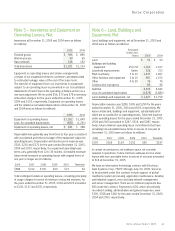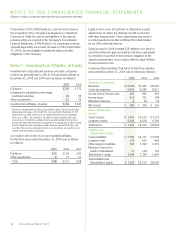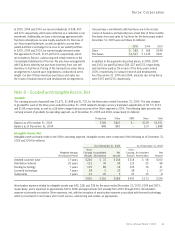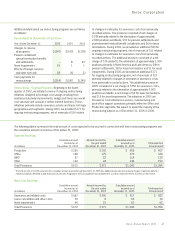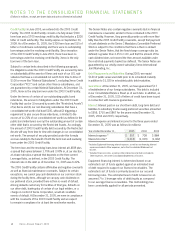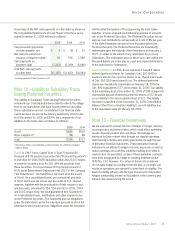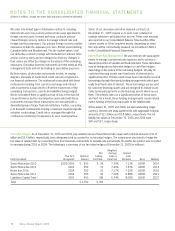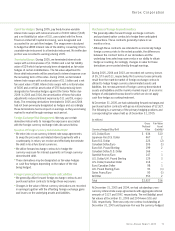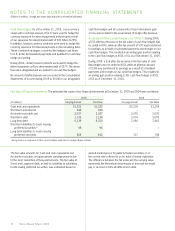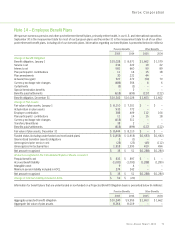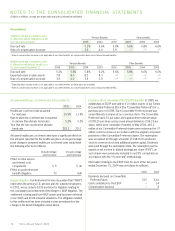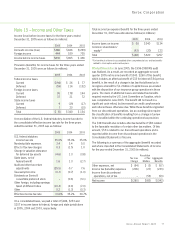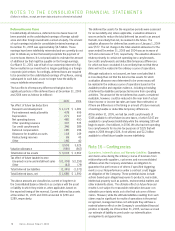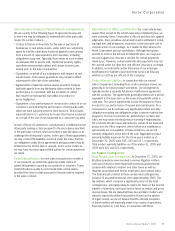Xerox 2005 Annual Report Download - page 79
Download and view the complete annual report
Please find page 79 of the 2005 Xerox annual report below. You can navigate through the pages in the report by either clicking on the pages listed below, or by using the keyword search tool below to find specific information within the annual report.
Xerox Corporation
71
Cash Flow Hedges: During 2005, pay fixed/receive variable-
interest rate swaps with notional amounts of £200 million ($345)
and a net liability fair value of $(1), associated with the Xerox
Finance Limited GE Capital borrowing, were designated and
accounted for as cash flow hedges. The swaps were structured
to hedge the LIBOR interest rate of the debt by converting it from
avariable-rate instrument to a fixed-rate instrument. No ineffective
portion was recorded to earnings during 2005.
Terminated Swaps: During 2005, we terminated interest rate
swaps with a notional value of $1.3 billion and a net fair liability
value of $29 which had previously been designated as fair-value
hedges of certain indebtedness. The fair-value adjustment to
these debt instruments will be amortized to interest expense over
the remaining term of the notes. During 2004, we terminated
interest rate swaps with a notional value of $1.1 billion and a net
fair asset value of $68. Interest rate swaps with a notional value
of $600 and a net fair asset value of $55 had previously been
designated as fair-value hedges against the Senior Notes due
2009. In 2005 and 2004, the amortization of these fair-value
adjustments reduced interest expense by $11 and $9, respec-
tively.The remaining derivatives terminated in 2005 and 2004
had not been previously designated as hedges and accordingly
those terminations had no impact on earnings as they were being
marked to market through earnings each period.
Foreign Exchange Risk Management: Wemay use certain
derivative instruments to manage the exposures associated
with the foreign currency exchange risks discussed below.
Issuance of Foreign Currency Denominated Debt
•Weenter into cross-currency interest rate swap agreements
to swap the proceeds and related interest payments with a
counterparty. In return, we receive and effectively denominate
the debt in local functional currencies.
•We utilize forward exchange contracts to hedge the
currency exposure for interest payments on foreign currency
denominated debt.
•These derivatives may be designated as fair-value hedges
or cash flow hedges depending on the nature of the risk
being hedged.
Foreign Currency Denominated Assets and Liabilities
•Wegenerally utilize forwardforeign exchange contracts and
purchased option contracts to hedge these exposures.
•Changes in the value of these currency derivatives are recorded
in earnings together with the offsetting foreign exchange gains
and losses on the underlying assets and liabilities.
Purchases of Foreign-Sourced Inventory
•We generally utilize forward foreign exchange contracts
and purchased option contracts to hedge these anticipated
transactions. These contracts generally mature in six
months or less.
•Although these contracts are intended to economically hedge
foreign currency risks to the extent possible, the differences
between the contract terms of our derivatives and the
underlying forecasted exposures reduce our ability to obtain
hedge accounting. Accordingly, changes in value for these
derivatives are recorded directly through earnings.
During 2005, 2004 and 2003, we recorded net currency losses
of $5, $73 and $11, respectively. Net currency losses primarily
result from the mark-to-market of foreign exchange contracts
utilized to hedge foreign currency denominated assets and
liabilities, the re-measurement of foreign currency-denominated
assets and liabilities and the mark-to-market impact of economic
hedges of anticipated transactions for which we do not apply
cash flow hedge accounting treatment.
At December 31, 2005, we had outstanding forward exchange and
purchased option contracts with gross notional values of $2,927.
The following is a summary of the primary hedging positions and
corresponding fair values held as of December 31, 2005:
(in millions)
Gross Fair Value
Notional Asset
Currency Hedged (Buy/Sell) Value (Liability)
U.S. Dollar/Euro $ 634 $10
Japanese Yen/U.S. Dollar 467 2
Euro/U.S. Dollar 225 (2)
Canadian Dollar/Euro 205 (1)
Euro/U.K. Pound Sterling 199 2
Canadian Dollar/U.S. Dollar 166 –
Swedish Kronor/Euro 147 1
U.S. Dollar/U.K. Pound Sterling 129 3
U.S. Dollar/Canadian Dollar 118 –
Euro/Canadian Dollar 98 1
U.K. Pound Sterling/Euro 93 (1)
Swiss Franc/Euro 93 (1)
All Other 353 2
Total $2,927 $16
At December 31, 2005 and 2004, we had outstanding cross-
currency interest-rate swap agreements with aggregate notional
amounts of $127 and $597, respectively. The net (liability) asset
fair values at December 31, 2005 and 2004 were $(5) and
$44, respectively. There was only one contract outstanding at
December 31, 2005 and Japanese Yen was the currency hedged.
Xerox Annual Report 2005


